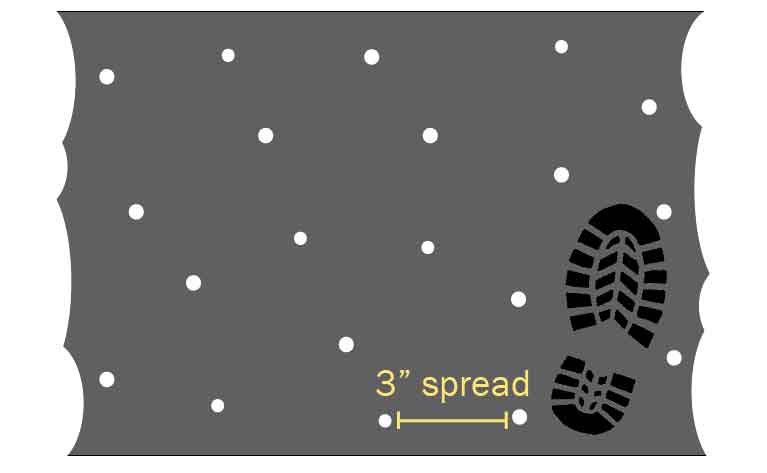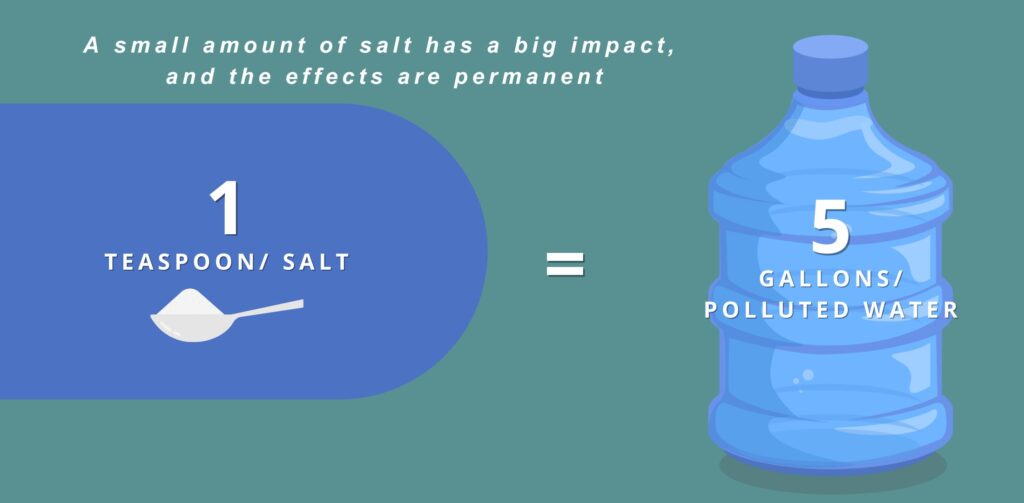Don’t Be Salty!
How de-icing salt is impacting Minnesota’s water and what you can do about it.

Written by Whitney Barkley, AmeriCorps Intern serving at Urban Roots
Minnesota, land of 10,000 lakes, we are known for our sparkling lakes and rivers here in the North Star State! Iconic waterways central to our ways of life–bringing food, recreation, and business while also supporting our abundant ecosystems. But, quietly and for decades, our water has been threatened by an unlikely culprit–salt. Sodium chloride and magnesium chloride, or salt, can be cheap and extremely effective for a variety of uses. However, salt also permanently pollutes any water it encounters. Our intentions are largely altruistic and practical. Neighbors sprinkle it on a sidewalk for the mail carrier, plow trucks make our highways driveable, the local grocer applys it on the parking spaces in front of the market so people can buy food safely, we all have been applying this product with the intention of safety of our loved ones. However, this has led to most of us Minnesotans unintentionally polluting our beloved waterways.
The Minnesota Pollution Control Agency has some great visuals and data for us on the topic. One teaspoon of salt permanently pollutes five gallons of water to a level that is toxic to aquatic life. In the Twin Cities we use 349,000 tonnes of de-icing¹ salt and 78% of that salt ends up back in our water to accumulate year after year.² And though salt is incredibly cheap, its over-application costs us–BIG. Salt does more to harm our water, it also negatively impacts hardscapes, infrastructure, vehicles, and vegetation. Reducing how much we apply to our roads by even 10% would save us 2.5 million dollars every year in the Twin Cities.¹ Reducing it by 70%, and remember that’s how much ends up back in our water, would save us–drum roll please–$17.8 million annually!¹
Okay, so, how do we keep our walking and driving spaces safe while protecting our water and wildlife? Minnesota’s water advocates and scientists have been diligently working on how to address this issue and ways we can all make a difference. There are things we can do to save ourselves money, stay safe, and protect the water we all love and rely on. The tips and tricks below are all pulled together from agencies, organizations, and advocacy groups who have been working together tirelessly on this issue. There are many resources and a lot of tools and information available to the public, businesses, and municipalities. Minnesota GreenCorps members developed a Salt Mini-Course that teaches about how salt impacts the environment and best practices for snow and ice removal. The Minnesota Pollution Control Agency also has a variety of trainings about de-icing salt and best practices for specific uses in Smart Salt Training. The Mississippi Watershed Management Organization also put together a great short video about improving our winter maintenance and making good choices for clean water. And the Hennepin County Chloride Initiative has just launched their Low Salt, No Salt Minnesota program. We Minnesotans care about our water!
What can you and I do, right now, today? Best practice for de-icing salt is to know when to apply it and how much. Salt doesn’t always work. Let’s talk.
- Strap on those boots! Using old fashioned elbow grease methods is extremely effective at mitigating salt application. Visit your local hardware store for tools such as shovels, ice scrapers and chisels, snow blowers, and even brooms or leaf blowers to remove accumulated snow and ice from paths. Try to stay on top of snow as it’s falling so ice is less likely to form. Help those who are less likely to be able to keep up on their snow if you’re able!
- Burr! It’s cold out here! Ice creates dangerous conditions for pedestrians and drivers because it’s slippery! De-icer has limitations based on temperature though. 15°F and below is too cold for salt! It doesn’t work. Sometimes our winter days are simply too cold to use salt. Grit, gravel, and sand often work when traction is required. These products are inexpensive, can be reused, and are available at most hardware stores. Some cities even offer free sand to residents for this purpose!
- Whoa Nellie! Wait! Before you lay down salt, are you applying too much? The Minnesota Pollution Control Agency recommends ½ a coffee mug of de-icer for a space the size of a parking spot. A full mug will cover about 10 sidewalk squares or a 20 foot driveway. Salt that isn’t melting ice, or is left over after the job is done, will end up in our waterways. Sweep up extra salt for use later and sparingly apply salt to areas where other methods will not work. Only ever apply salt on top of ice, avoid putting it on snow or pre-emptively laying down salt on bare pavement. Grains of salt should be about three inches apart from each other.

- 4. Pay it forward. Our water in Minnesota is invaluable to us all, we know. So on your next fishing trip, talk to your friends about salt and how it’s impacting our home and the food you are hoping to catch. Have the muscles for it? Help your neighbor shovel so they can avoid using short term conveniences like de-icing salt. Volunteer, work, or worship somewhere? Let them know about salt’s impact on water and how to salt smarter. No one knows your loved ones and neighbors better than you do! Tell them why this is important in a way that will matter to them. If you have the time and passion, consider becoming a Minnesota Water Steward!
Salt permanently pollutes our water. Drinking water and ecosystems are at risk from what has become commonplace practice in winter meant to keep our lives running and our loved ones safe. But what we have been doing is unintentionally robbing Peter to pay Paul and our iconic waters are now at risk. There’s no need to be salty about the issue, though! Minnesota is paving the way in developing best practices for tackling this problem, and so are the everyday heroes such as you, reader, who are taking time to commit to learning about salt and ways you can be more conscious and productive about winter maintenance going forward! Onward!


